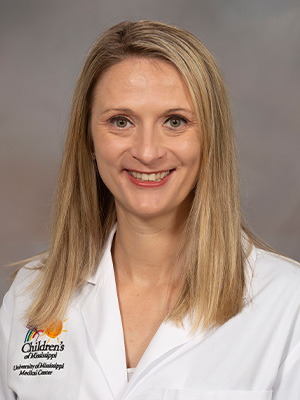Pediatric rheumatologists see symptoms from head to toe
Joint pain and inflammation of the eyes in children may prompt parents and pediatricians to consult with specialists such as pediatric orthopaedists and ophthalmologists.
A specialty that should also be considered: pediatric rheumatology.

Symptoms of many rheumatological and autoimmune diseases can be mistaken for other illnesses, said Dr. Laura Tasan, assistant professor of pediatric rheumatology at the University of Mississippi Medical Center.
Tasan offers care twice a month at the Children’s of Mississippi Cedar Lake Pediatric Clinic at 920 Tommy Munro Drive in Biloxi, treating conditions such as juvenile idiopathic arthritis, autoimmune diseases such as lupus and dysautonomic conditions such as postural orthostatic tachycardia syndrome, or POTS.
“Pediatric rheumatologists work to provide comprehensive care for the unique needs of each child with a rheumatic, autoimmune or dysautonomic condition,” she said. “Our focus is not just on treating the disease but also on supporting the overall well-being and quality of life of our young patients."
Rheumatic conditions are those that affect the joints, muscles, bones or connective tissues. These conditions are typically characterized by inflammation, pain, stiffness, and swelling in the affected areas. These can include a broad spectrum of diseases, including autoimmune diseases such as rheumatoid arthritis, systemic lupus erythematosus and juvenile idiopathic arthritis, as well as non-autoimmune conditions such as osteoarthritis, gout, and fibromyalgia.
Dysautonomic conditions involve the dysfunction or impairment of the autonomic nervous system, which is responsible for regulating involuntary bodily functions such as heart rate, blood pressure, digestion and temperature control.

Dr. Patrick Wright, associate professor of orthopaedic surgery, said signs that a patient needs care from a rheumatologist include pain for longer than six months with no clear cause, pain in multiple joints, a family history of rheumatological conditions and intermittent stiffness, swelling, warmth or redness in the joints involved.
Within juvenile idiopathic arthritis diagnoses are subsets, based on what joints are involved, how many joints, and serology such as ANA, Rheumatoid factor or the gene HLAB27, Tasan said.
“Patients are placed in different categories, which allows us to predict their clinical course,” she said. The goal is to prevent symptoms and joint damage now and into a patient’s adult years.
“Patients who do not have any positive serology and only have one joint are most likely to have their immune system become more regulated and not have symptoms into adulthood, while patients with rheumatoid factor positivity likely will have arthritis into adulthood. Since we are treating the arthritis, we can prevent any joint damage from causing disability in the future, and they overall can have a good prognosis, because of being monitored closely.”
Lab results are important, but symptoms and a clinical examination are also needed for a diagnosis. “Labs alone do not diagnose arthritis, which is extremely important to understand,” she said. “In addition, 30 to 40% of children with arthritis do not have positive findings in their labs.”
Eye check-ups for patients with juvenile arthritis are essential, she said.
“Most people are not aware that patients with juvenile arthritis are also at risk for eye inflammation (uveitis).” she said. “It is critical that these patients be screened by an ophthalmologist with a dilated exam.”

Uveitis, which may not have symptoms, can lead to a loss of vision, said Dr. Nils Mungan, professor of ophthalmology.
“For patients with juvenile idiopathic arthritis, the uveitis is often silent, with no symptoms at all until irreversible damage has been done,” he said. “It is very important for children with juvenile idiopathic arthritis to get regular detailed eye examinations from ophthalmologists.”
Ophthalmologists have special microscopes called slit lamps to look inside the eye and detect uveitis in its earliest stages before permanent damage is done, he said.
“Depending on the type of juvenile idiopathic arthritis, these exams may need to occur as often as every three months, even if the child has perfect vision and is experiencing no pain,” he said. “If uveitis is detected early enough, it can usually be treated successfully with eye drops or sometimes more advanced arthritis medications.”
Left untreated, uveitis carries a high risk of blindness from glaucoma, corneal scarring, cataracts or retinal scarring.
“The eye examination needed to detect uveitis is usually brief and painless, and well worth the trip to the ophthalmologist.”
The above article appears in CONSULT, UMMC’s monthly e-newsletter sharing news about cutting-edge clinical and health science education advances and innovative biomedical research at the Medical Center and giving you tips and suggestions on how you and the people you love can live a healthier life. Click here and enter your email address to receive CONSULT free of charge. You may cancel at any time.



